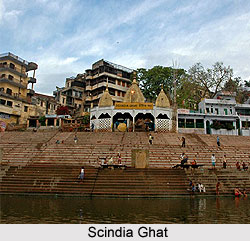 The Scindia Ghat, located in Varanasi, borders the Mani Karnika Ghat in the north side. This picturesque ghat is also known by the name Shinde Ghat. The ghat is visited by many devotees from different places who come here to bath in the holy water and get rid of their sins. It was built by Baija Bai, the same lady who erected the colonnade round the Gyan Bapi well. Above the ghat there are several temples. These are located in the firm maze of alleyways of the area that is known as Siddha Kshetra or the field of Fulfilment. It is said that the Lord of Fire, Lord Agni, was supposed to have been born here. Devotees pray here and propitiate Lord Shiva for a son.
The Scindia Ghat, located in Varanasi, borders the Mani Karnika Ghat in the north side. This picturesque ghat is also known by the name Shinde Ghat. The ghat is visited by many devotees from different places who come here to bath in the holy water and get rid of their sins. It was built by Baija Bai, the same lady who erected the colonnade round the Gyan Bapi well. Above the ghat there are several temples. These are located in the firm maze of alleyways of the area that is known as Siddha Kshetra or the field of Fulfilment. It is said that the Lord of Fire, Lord Agni, was supposed to have been born here. Devotees pray here and propitiate Lord Shiva for a son.
The Scindia Ghat has been remarkable for the massiveness of its masonry. According to its history the temple in this ghat dedicated to Lord Shiva lies partially submerged in the river. It fell in as a result of the excessive weight of the ghat`s construction around 150 years ago. It is said that it is still gradually and slowly sinking. Scindia Ghat consists of three rows of low towers or turrets. The uppermost row is made of two turrets. These two turrets are located at each extremity. These are regarded as the largest of all the turrets and are remarkably massive. The second lower down has six turrets and the third has five turrets. The people residing here call these turrets as marhis. These are usually used by them as a place to sit on a cool day or for resting after bathing in the Ganges. The turrets are made of stone and have been connected together by walls and stairs also made of stone. However, before the ghat could be completed, the masonry began to sink due to too much weight. It is said that once the motion was so violent that a loud noise was heard by the natives of this place.
There is a temple built to the left of the south turret. It is in complete dilapidated state. The ghat and also the stairs leading up to the top unite the two largest turrets. It is carried down to the very base of the ghat. In some places the stones can be seen more than two feet apart. It is said by the people residing here that the ghat has sunk some ten or twelve feet in all and still stair after stair continually, though slowly, keeps vanishing giving the hint that the process is still going on.



















